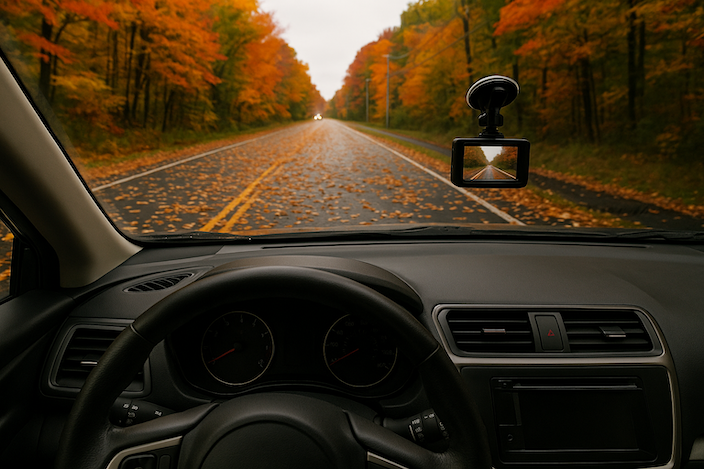Fall Car Crashes: When Leaf-Peeping Goes Wrong

Fall in Maine looks like a postcard—until a short drive to see the foliage turns into a close call. As leaves peak and weekends fill with visitors, crash risk quietly climbs. You can stay safe (and protect your rights if someone hits you) by understanding the less obvious dangers that show up between late September and early November—and how to respond when they do.
Why autumn roads turn risky
Tourist traffic alone doesn’t tell the whole story. Several seasonal factors combine to create tricky, fast-changing conditions:
- Wet leaves act like ice. Water-slicked leaves create a low-friction layer that robs your tires of grip, especially at intersections and on curves.
- Leaf piles hide hazards. Raked piles along curbs can conceal potholes, storm grates, and sharp edges that can pull a wheel off line.
- Low sun = severe glare. The sun sits lower on the horizon. Morning and late-day glare can blind drivers for seconds—long enough to miss a brake light or a pedestrian.
- Fast temperature swings. Bridges and shaded stretches can form early frost even when the rest of the road looks dry.
- Wildlife on the move. Deer and moose become more active at dawn and dusk. A sudden swerve often causes the crash—not the animal itself.
- School and event traffic. Buses, new teen drivers, Friday night games, and fall festivals create unpredictable stops and turns.
- Underinflated tires. Colder air drops tire pressure, lengthening stopping distance and reducing cornering grip.
Practical steps that actually reduce risk
You don’t need to overhaul your routine. Make a few targeted adjustments and you dramatically cut crash odds:
- Slow 5–10 mph earlier than usual when you see leaf cover ahead, especially approaching stops and downhill bends.
- Add a full second to your following distance in leaf-covered or shaded areas.
- Avoid braking on leaves. Brake before you reach them, then roll through gently with the wheel straight.
- Treat bridges like winter. Expect frost overnight and in the early morning; accelerate and brake gently.
- Fight glare proactively. Keep your windshield streak-free, use your visor, and keep a pair of polarized sunglasses within reach.
- Check tire tread and pressure. Aim for at least 4/32″ tread before heavy fall rains. Set pressures to the door-jamb spec when “cold.”
- Use your lights early. Turn on headlights at the first hint of rain, fog, dusk, or glare so others can see you.
- Don’t drive through leaf piles. They can hide kids, pets, nails, and road-edge drop-offs.
- Plan around peak leaf-peeping times. If you can, avoid late-morning Saturday and mid-afternoon Sunday on scenic routes and near trailheads.
- Consider a dashcam. Clear video of speed, spacing, and road surface often resolves fault quickly.
If a crash happens, protect your health—and your claim
You can’t undo a collision, but you can lock down the facts that matter:
- Call 911 and get medical care even if you “feel fine.” Adrenaline can mask injuries.
- Photograph the scene immediately. Include wide shots and close-ups of:
- Leaf coverage, puddles, frost, or glare direction (shoot toward and away from the sun).
- Skid marks—or the lack of them—on leaf-covered pavement.
- Vehicle positions, damage points, and any hidden hazards (potholes under leaves, obscured signage).
- Capture the conditions. Snap a quick screenshot of your weather app for time, temperature, and light status; note the exact location.
- Identify witnesses and get contact info; tourists may leave the state within hours.
- Avoid roadside admissions. Stick to facts for police; don’t speculate about fault.
- Tell your insurer promptly but avoid recorded statements until you understand your options.
How a Maine injury lawyer builds a fall-hazards case
Autumn crashes often involve comparative fault arguments—insurers may claim “no one could have stopped on leaves” or “glare made it unavoidable.” A seasoned Maine personal injury lawyer investigates beyond the surface:
- Roadway condition analysis: Photos, dashcam footage, and on-scene measurements show where leaves, frost, or glare influenced braking and sightlines.
- Maintenance and notice: Requests for municipal or property-owner leaf-removal schedules, drainage issues, and prior complaints can establish negligence.
- Sun and weather data: Objective records (sun angle at the crash minute, temperature, dew point) test whether a driver should have anticipated glare or frost.
- Speed and spacing reconstruction: Event data recorders, video frame analysis, and crush patterns help determine whether a following driver was too close.
- Wildlife collision nuance: Evidence can show that unsafe speed, not the deer, caused the loss of control—critical for liability.
- Insurance strategy: Your attorney identifies all coverages (including MedPay and UM/UIM) and counters blame-shifting with hard data.
If someone’s negligence hurt you or a loved one—whether they tailgated into wet leaves, drove blinded into a crosswalk, or sped across a frosty bridge—you have options. The sooner you preserve evidence, the stronger your claim.
Talk to a Maine attorney who knows fall roads
Peter Thompson & Associates represents crash victims across Maine year-round, including the unique hazards that arrive with foliage season. We’ll review your case, explain your rights, and handle the insurers while you focus on recovery.
Free consultation. No fee unless we win. Call (207) 874-0909 or contact us online.

